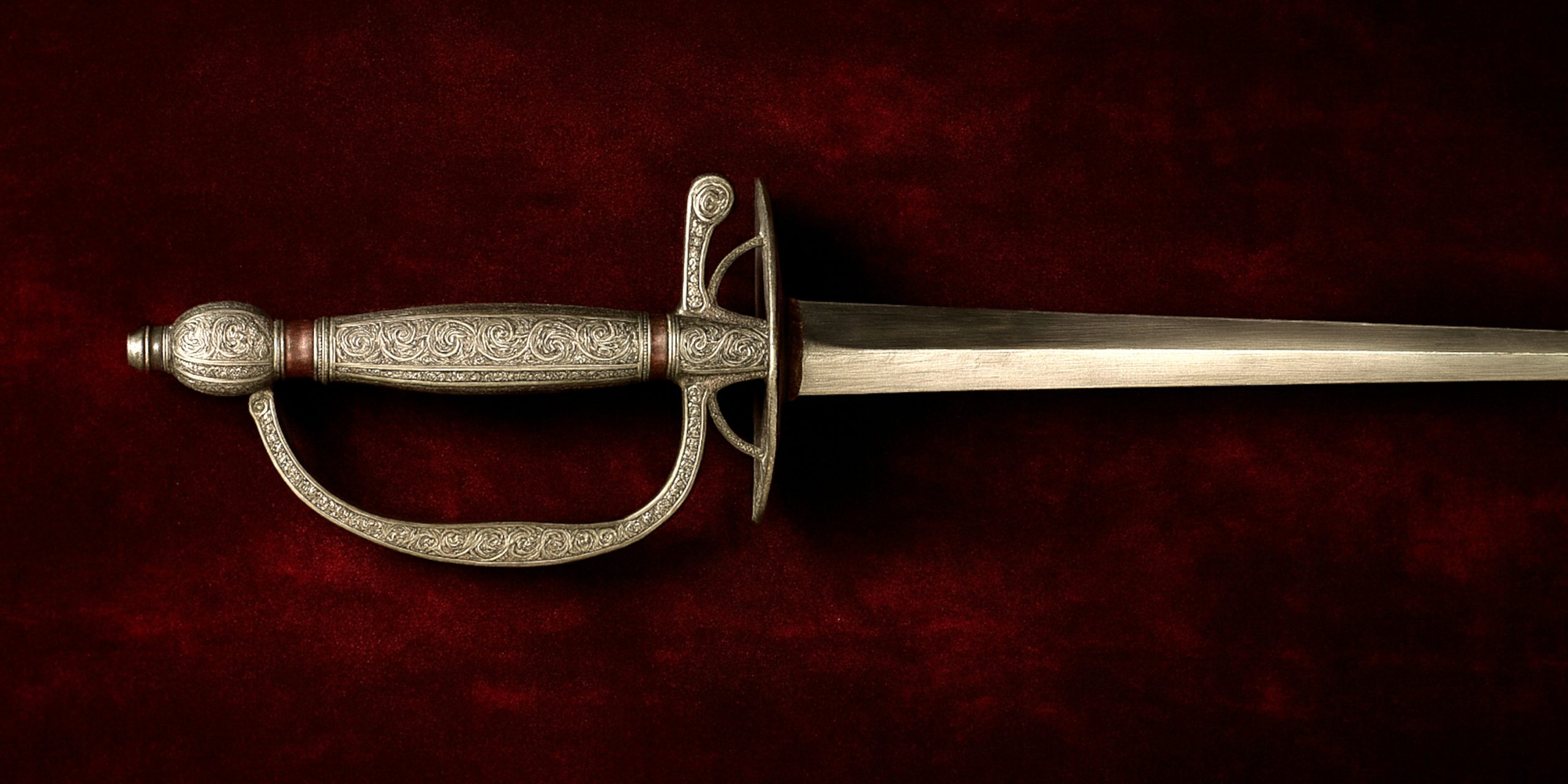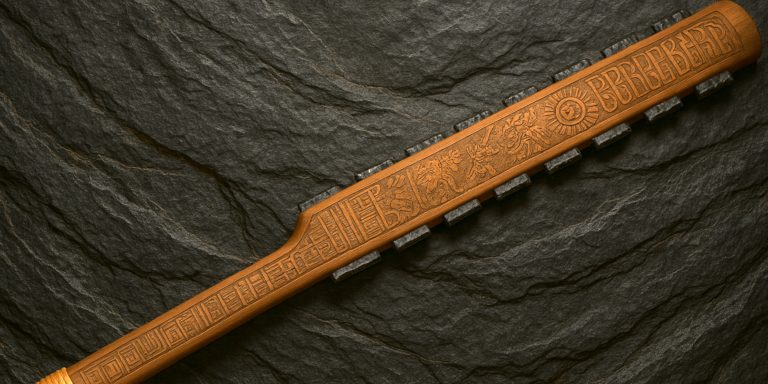
The Neapolitan sword is a refined yet formidable weapon that emerged in the Kingdom of Naples during the late Renaissance and Baroque periods. Distinguished by its elegant swept hilt, long slender blade, and intricate Italian craftsmanship, it became a symbol of both nobility and martial prowess.
Often mistaken for a rapier, the Neapolitan sword blended duelling grace with battlefield practicality. It represented a uniquely southern Italian approach to sword design, balancing ornamentation and function.
Specification
| Feature | Description |
|---|---|
| Origin | Kingdom of Naples (Southern Italy) |
| Type | One-handed thrusting and cutting sword |
| Period of Use | Late 16th to 18th centuries |
| Blade Length | 90–110 cm (approx.) |
| Overall Length | 110–125 cm |
| Blade Type | Tapered, double-edged or back-edged; often diamond or lenticular cross-section |
| Hilt Style | Swept or cup hilt; ornate guard with side rings, knuckle bow, and quillons |
| Grip Material | Wire-bound wood or ray skin, often gilded or decorated |
| Pommel | Globular or faceted, sometimes engraved |
| Weight | Typically 1.1–1.4 kg |
| Balance Point | 10–15 cm from the guard, optimised for thrusting |
| Primary Function | Civilian self-defence, duelling, and ceremonial wear |
History and Evolution
The Neapolitan sword developed during the height of Italian fencing schools, when southern Italy maintained close artistic and military ties with Spain. Naples, as a cultural centre under Spanish influence, adapted the Iberian rapier into its own regional form.
Early Period (Late 16th Century)
- Influenced by Spanish and Venetian sword design.
- Early blades were longer and heavier, suitable for both thrusting and limited cutting.
- Used by noblemen, officers, and fencing masters.
17th Century Refinement
- Adoption of swept and cup hilts for improved hand protection.
- Blade profiles became narrower, reflecting the dominance of the thrust in fencing manuals.
- Decorative elements, including chiselled guards and inlaid hilts, became hallmarks of Neapolitan craftsmanship.
18th Century and Decline
- As pistols replaced swords in civilian defence, the Neapolitan sword evolved into a ceremonial or parade weapon.
- Court swords and smallswords replaced functional rapiers, though Neapolitan smiths continued to craft ornate presentation pieces.
- By the Napoleonic era, it was largely obsolete as a combat weapon.
Advantages and Disadvantages
Advantages
- Elegant yet functional: Designed for thrusting with precise control.
- Excellent craftsmanship: Naples’ swordsmiths were renowned for balance and decorative artistry.
- Protective hilt: Swept or cup hilts offered superior hand protection during fencing.
- Status symbol: Worn as a marker of education, honour, and class.
Disadvantages
- Limited cutting ability: The narrow blade was less effective in slashing combat.
- Fragility: Some decorative examples sacrificed strength for aesthetics.
- Civilian focus: Less suitable for military use compared to sabres or broadswords.
- High cost: Quality craftsmanship placed it out of reach for common soldiers.
Comparison with Similar Weapons
| Weapon | Origin | Key Features | Comparison to Neapolitan Sword |
|---|---|---|---|
| Spanish Rapier | Spain | Long, thrust-oriented blade with complex hilt | The Neapolitan sword is shorter and lighter, with Italian design flair. |
| Venetian Schiavona | Venice | Broad blade, basket hilt | The Schiavona was a battlefield weapon; the Neapolitan sword was a duelling and dress arm. |
| French Smallsword | France | Light, courtly thrusting sword | The smallsword descended from the Neapolitan style but was purely ceremonial by the 18th century. |
| German Sidesword | Holy Roman Empire | Versatile cut-and-thrust blade | The Neapolitan variant was more refined and suited for civilian use. |
Legacy
The Neapolitan sword occupies an important niche in the story of European fencing. It symbolised the sophistication of Italian martial arts and the blending of Spanish influence with local craftsmanship. Its evolution reflects the broader European shift from battlefield combat to personal duelling and ceremonial display.
Modern fencing schools studying Italian rapier techniques often reference Neapolitan examples for their elegant balance and fine handling. Surviving pieces are treasured in museums and private collections for their aesthetic and historical value.
Where to See
| Location | Institution | Notes |
|---|---|---|
| Naples, Italy | Museo di Capodimonte | Collection includes Neapolitan rapiers and decorative swords. |
| Florence, Italy | Stibbert Museum | Houses several Neapolitan and Spanish-Italian hybrid swords. |
| London, UK | Wallace Collection | Exemplary Italian rapiers and regional swords, including Neapolitan types. |
| Paris, France | Musée de l’Armée | Displays several Italian rapiers from southern workshops. |
| Madrid, Spain | Royal Armoury | Contains swords showing the Spanish influence on Neapolitan designs. |
Collectors Guide and Auction Prices
Collecting Neapolitan swords is a niche pursuit within the field of European arms. Their ornate construction and scarcity make them highly sought after by museums and private collectors.
Collector Insights
- Authentic examples often feature hand-chiselled guards, signed blades, or engraved hilts.
- Provenance and decorative quality strongly affect value.
- Be wary of later reproductions; 19th-century ceremonial swords are common.
- Restoration should be minimal to retain historical patina.
Recent Auction Trends
| Auction House | Year | Item Description | Sold Price (GBP) |
|---|---|---|---|
| Bonhams, London | 2023 | 17th-century Neapolitan swept-hilt sword | £9,800 |
| Sotheby’s, Paris | 2022 | Neapolitan rapier with gilded hilt | £11,200 |
| Hermann Historica, Munich | 2021 | Cup-hilt sword, Naples workshop | £7,400 |
| Christie’s, London | 2020 | Decorated Neapolitan ceremonial sword | £12,500 |
| Czerny’s, Sarzana | 2019 | Signed blade “Ferrara” Neapolitan type | £8,300 |
Collector Value Range
- Functional examples: £5,000–£8,000
- Decorated pieces: £8,000–£12,000
- Museum-grade or signed works: £12,000–£18,000+
The Seven Swords Takeaway
The Neapolitan sword stands as a masterpiece of Italian artistry and fencing heritage. Bridging the gap between the deadly rapier and the decorative smallsword, it represents an age when the blade was as much a statement of culture as of combat. Whether admired for its beauty, balance, or craftsmanship, it remains a prized relic of southern Italy’s martial identity.



